You’ve eagerly torn open the anticipated envelope to read great granny’s parents’ names, but what have you ignored? The Registrar. Without the person registering births, marriages and deaths we wouldn’t have this information at all. Who was the faceless figure who signed each certificate? Adèle Emm investigates
The bricks and mortar of family history - civil registration of births, marriages and deaths in England and Wales - came into force on 1 July 1837 (1855 in Scotland. 1864 in Ireland, Protestant marriages from April 1844).
It was the simultaneous nativity of the General Record Office (GRO), when 2,993 registrars of births and deaths plus 619 superintendent registrars poised quills. In overall charge, the first Registrar General appointed by letters patent in August 1836 was novelist Thomas Henry Lister (1800-42).
How were registrars recruited?
Because registrars required a high degree of literacy, organisational skills and trust, he (female Registrars weren’t appointed until the late 19th century) often already held a position of responsibility. By late 1836, advertisements were placed in newspapers targeting those who could both read and afford them (newspaper stamp tax was abolished on 30 June 1855). As this was a totally new concept, responsibilities, salary and accoutrements to fulfil the role were explained. Salary, marriage-notice-book, forms and certificates plus iron coffer for storage were all financed by the new Poor Law taxpayers.
An advert on the front page of the Norwich Mercury from 29 January 1848 combined the role of Relieving Officer for the Poor with Registrar for Fakenham, Norfolk. Aged 25 to 50, ‘no Person need apply who is not possessed of a thorough knowledge of Account-keeping, or who cannot spell correctly, and also write a plain and legible hand, and give the most unexceptionable references and testimonials in writing, as to sobriety and business-like habits.’ The Relieving Officer’s job paid £105 per annum with an estimated £25 for registrar’s duties. Their interview was held the next week at Great Snoring Union Workhouse.
In the early days, registrar was a part-time job for people such as accountants, solicitors and surgeons. In 1845, grocer and tea dealer John Shawcross of 44 Chestergate (both his home and office), was births and deaths registrar for Stockport Union. Initially registrars were based at the workhouse, at their business premises or home (precluding anyone with a small house). George Mason, 1907 registrar for marriages for the whole of Manchester township, worked from Lever Street Sunday School.
The Clerk to the Board of Guardians was commonly appointed Superintendent Registrar. Until 1918, Manchester’s Superintendent Registrar was based at the Poor Law Guardians’ office, New Bridge Street Workhouse, with satellite register offices littered around the city.
What did the work of a registrar involve?
A registrar’s job was largely administrative; keeping accounts of fees paid, signing and giving out certificates. Once a quarter, they sent hand-written copies of births and deaths to the superintendent registrar. Paid from parish funds, their first annual 20 entries received 2 shilling and 6 pence (2s 6d), the rest 1s. The Superintendent Registrar made quarterly returns to the GRO and took custody of completed registers. He also submitted annual abstracts of the number of births, marriages and deaths to parliament.
Hours of attendance were advertised; for instance, weekdays 10-4 and Saturdays 10-1 for Chorlton cum Medlock, Manchester in 1907. Daniel Boyle, registrar for industrial Ancoats based at 41 Carruthers Street was open for business Monday, Wednesday, Friday, Saturday 10-1 and 2- 4: and, targeting factory hands, Tuesdays and Thursdays 4-7pm.
Registrars were crucial to each decade’s census. The Registrar General supervised overall responsibility but, countrywide, local registrars ensured all households within their district were counted.
Adèle Emm is a writer, genealogist and social historian. Visit her website.








